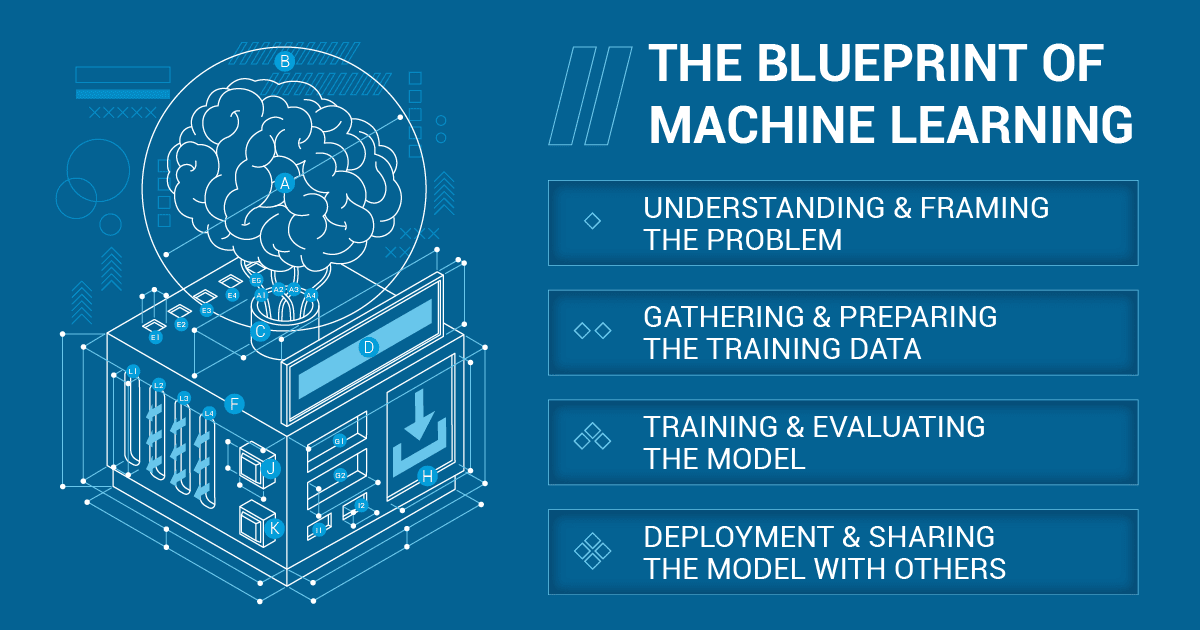Picture this — you’re learning to ride a bike. Remember how you learned to balance, pedal, and steer? It took a bit of stumbling, perhaps a few grazed knees. But with every fall, you learned something new, adjusting your balance and your grip, getting better each time until you were cycling like a pro!
Well, machine learning isn’t too dissimilar. It is a process where we teach computers to learn from data, much like how you learned to ride that bike. But instead of scraped knees, we have algorithms sifting through vast oceans of data, learning, adjusting, and improving, bit by bit.

The Essence of the Machine Learning Process
The machine learning process is a roadmap, a sequence of stages meticulously designed to create, train, and deploy a machine learning model. This is not just a process; it’s a journey, a saga of transforming raw data into knowledge and finding solutions hidden in the labyrinth of information. Through this process, we can craft systems that make predictions and decisions based on data, shedding the constraints of explicitly programmed rules. It gifts machines the ability to learn from the data they are fed, aiding in identifying patterns and trends that are not immediately obvious. Moving beyond rigid rule-based systems, machine learning facilitates the automation of decision-making, heralding a revolution in how we interact with technology.
At the heart of the machine learning process is data—a vast, rich, and diverse repository of information waiting to be explored and understood. An awe-inspiring aspect of this process is the system’s ability to improve over time, learning diligently from experience. This journey of continuous learning enables the creation of intelligent systems capable of gaining insights and adapting based on new data encountered. Without the machine learning process, we would find ourselves ensnared in an endless cycle of manual coding for every conceivable action or decision. Fortunately, machine learning models can learn and update their knowledge autonomously, ushering in an era of efficiency and intelligence.
As we venture further, we begin to grasp the machine learning process’s potential to maximize the wealth that data harbors. It can aid us in unearthing hidden relationships within data, shedding light on unseen patterns, and harvesting insights that fuel innovative, data-driven solutions to complex problems. The machine learning process stands as a sentinel of efficiency, automating analytical model building, thus saving time and streamlining processes, especially in large-scale systems.
One of the mesmerizing facets of the machine learning process is its ability to simplify complex problem-solving, breaking it down into manageable, distinct phases, each with a unique objective and a set of tasks to accomplish. This process encourages a focused approach, allowing us to zero in on individual phases addressing challenges efficiently and effectively.
Embrace the iterative nature of the machine learning process, a cycle of constant refinement and enhancement, enabling a dynamic evolution of the model that fosters continuous improvement.
The Blueprint of Machine Learning: A Step-by-Step Guide

1. Understanding and Framing the Problem
Before setting out on any adventure, it is essential to have a clear map and a defined destination. Similarly, the initial step in the machine learning process is to comprehend and frame the problem succinctly.
Defining the problem begins with laying out the business questions or challenges we aim to solve with our machine learning model. It’s the stage where curiosity meets clarity, setting the stage for the adventures ahead. Based on the problem at hand, we then decide on the type of machine learning model to apply. Be it supervised learning, guiding the model with labeled data; unsupervised learning, letting it find hidden patterns on its own; or reinforcement learning, where the model learns through trial and error, much like learning to ride a bicycle!
2. Gathering and Preparing the Training Data
With a clear objective in sight, we move to assemble our toolkit— the data. This step is pivotal in shaping the learning journey of our model. In order to accomplish this task, we must engage in:
- Data Collection: Amass data pertinent to the problem, forming the bedrock of our model’s learning landscape.
- Data Cleaning: Just as we wouldn’t add unnecessary ingredients while cooking, we clean the data, eliminating superfluous information.
- Data Preparation: When preparing data, we tailor it to suit the needs of our model, setting the stage for the training phase.
- Quality and Quantity: Remember, the efficacy of our model hinges significantly on the quality and the quantity of the training data, determining its predictive prowess.
3. Training and Evaluating the Model
As we journey further, we encounter the training grounds, where our model learns to find patterns and relationships within the data. During the training phase, the model immerses itself in the prepared data, learning to decipher patterns and understand relationships.
Post training, it’s time for a test! We evaluate the model using various measures such as accuracy, precision, or the F1 score to understand its proficiency. If the model doesn’t meet the standards, fear not! We revisit previous steps, tweaking and tuning, in a relentless pursuit of excellence, teaching our model to be better.
4. Deployment and Sharing the Model with Others
With the testing phase behind us, we deploy our model in a production environment, ready to make predictions on new data and assist in solving real-world problems. We then open the doors to the world, sharing our model through APIs for integration with other software or through insightful visualizations and reports, helping stakeholders grasp the fruits of our labor.
Chris’s Playlist Challenge: A Machine Learning Solution
Imagine Chris, a high school student who loves music just as much as his friend Sasha does. However, they both have diverse tastes in music. Chris is more into rock, while Sasha has a penchant for indie tunes. Chris wants to surprise Sasha by creating a playlist of songs that Sasha hasn’t heard before but would most likely enjoy. It sounds like a challenging task, doesn’t it? Well, let’s see how Chris can use the machine learning process to his advantage:
Chris begins by clearly defining his goal: to find undiscovered songs that align with Sasha’s music preferences. He decides to focus on identifying indie songs from less-known artists, assuming that Sasha hasn’t heard them yet.
To gather the necessary data, Chris notes down the songs and artists that Sasha has mentioned loving in the past. He even asks Sasha subtly about the characteristics she enjoys in a song without giving away his plan. He compiles a list of these preferences, which forms the data that will train his machine learning model.
Chris, then, uses this data to train his machine learning model, teaching it to understand the patterns and relationships in Sasha’s music preferences. It’s a phase of learning and fine-tuning where Chris might discover that Sasha has a soft spot for soulful lyrics or acoustic elements. After training the model with this data, Chris tests it by having it predict Sasha’s potential liking for a small set of songs. He reviews the predictions to see if they align with what he knows about Sasha’s tastes.
Satisfied with the machine learning model’s understanding, Chris uses it to curate a list of new songs that align with Sasha’s taste profile. It feels like magic as the model identifies songs Chris wouldn’t have thought of on his own.
Once Sasha listens to the playlist, Chris asks for her feedback. This is a crucial step because Sasha’s feedback will help Chris refine the model further. Machine learning is a continuous cycle of learning and improving, and Chris plans to use this feedback for any future surprises he has for Sasha, ensuring that every new playlist is just a bit more perfect than the last one.
Through this fun and thoughtful project, Chris not only surprises Sasha with a personalized playlist but also experiences firsthand the incredible potential of the machine learning process in solving complex problems and creating something truly special from a series of data points.